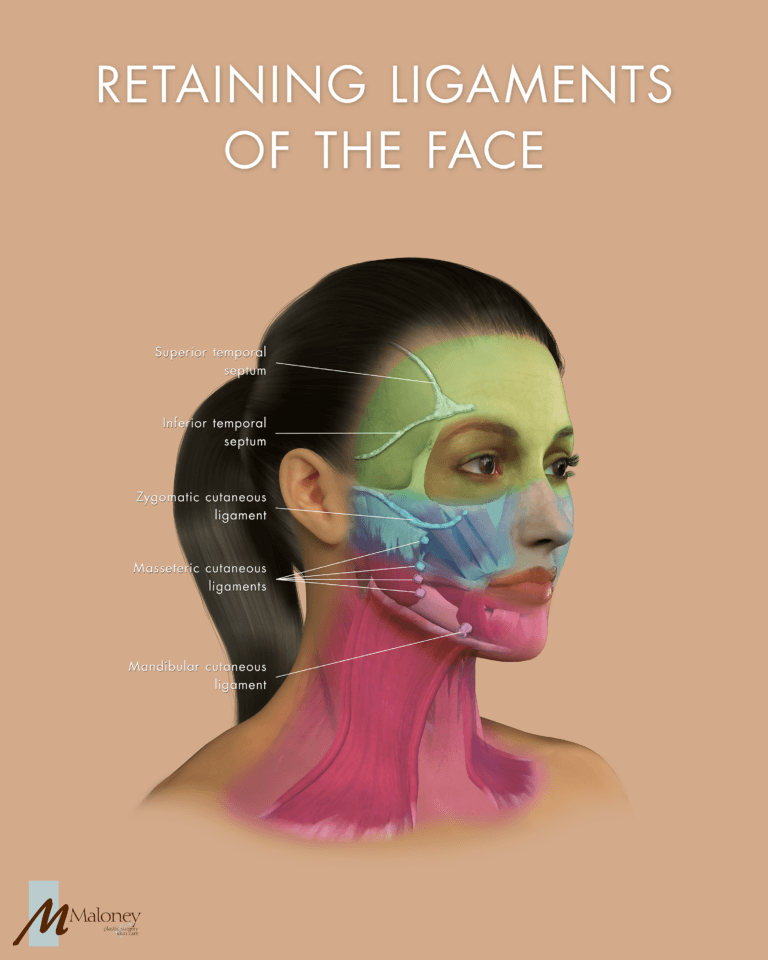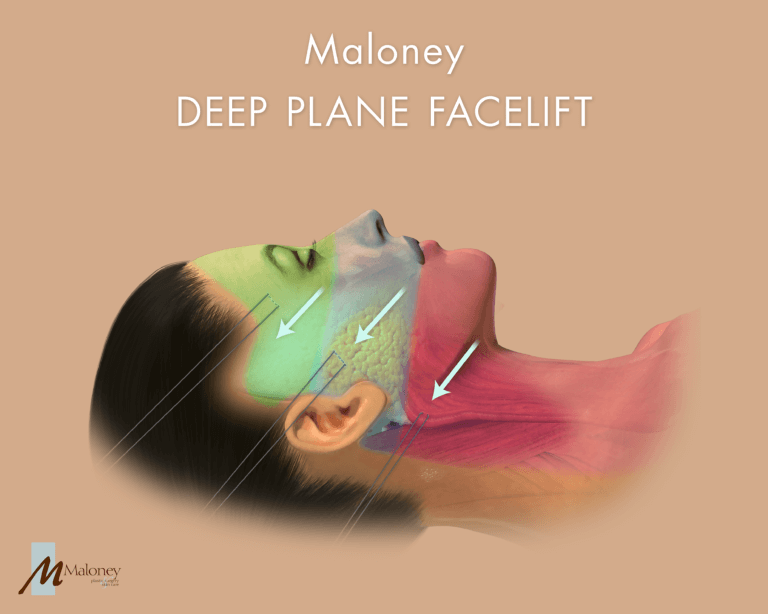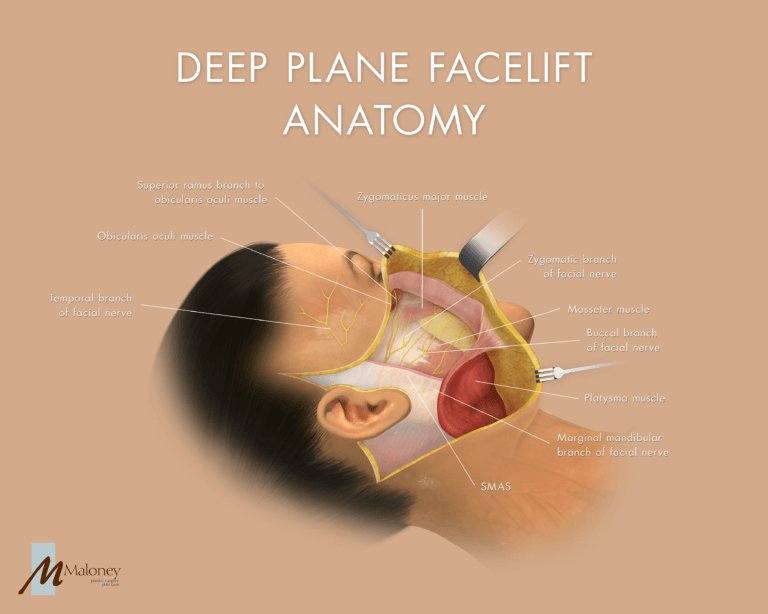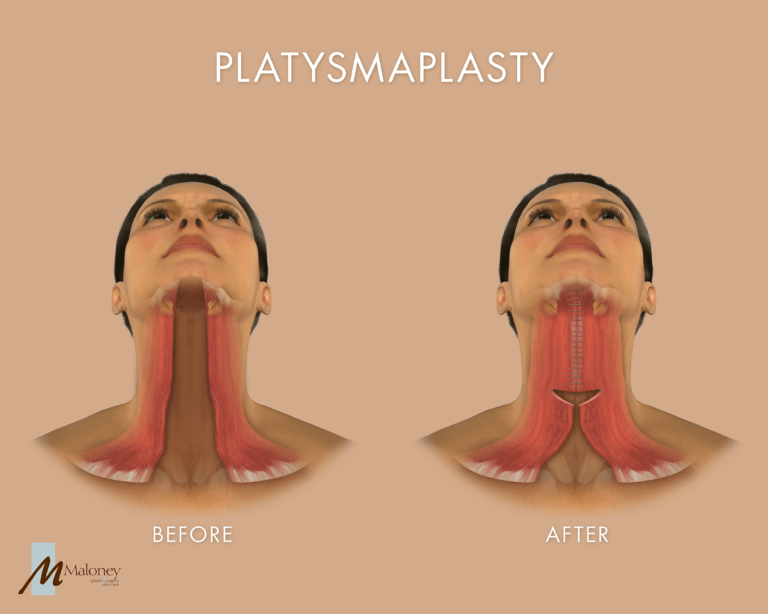Maloney Deep Plane Facelift
MALONEY DEEP PLANE FACE AND NECK LIFT
BY HARVARD TRAINED PLASTIC SURGEON CHRISTOPHER T. MALONEY JR., M.D.
The Maloney Deep Plane Facelift is best described as a triple facelift technique using a bilaminate approach that addresses all three areas of face; the upper, middle, and lower third.
Traditional facelift techniques historically focused mainly on the neck and jawline (the lower third of the face). More advanced techniques, such as the deep plane facelift (part of the Maloney Deep Plane Facelift), is a more technically aggressive facelift technique that includes releasing the facial retaining ligament in the middle and lower thirds of the face. This allows for more movement of the deep structures, including the SMAS and facial muscles.
The Maloney Deep Plane Facelift technique also addresses the lower third of the face and neck by tightening the platysma bands, the deeper neck structures as well as the jaw line area. This creates a more youthful jaw and neck line.
To address the upper third of the face, which includes the brow and temporal area, a more superficial skin only facelift is performed on the upper third of the face. This procedure allows for gentle gliding and elevation of the upper third of the face and brow for a natural and rejuvenated appearance.
The Maloney Deep Plane Facelift combines all three of these facial zones into one procedure, achieving total facial rejuvenation. Addressing all three levels of the face; the upper, middle and lower, results in a more complete and natural appearance.
The Maloney Deep Plane Facelift is usually performed in the office under local anesthesia to eliminate nausea, vomiting and “anesthesia hangover”. This also results in a faster recovery and less down-time.
Learn more about this innovative anesthetic technique in the anesthesia sections below.
WHY ADD A DEEP PLANE INTO A FACE LIFT
- Many facelift surgeons, including Dr. Maloney, believe the deep plane lift can offer a more natural result than lifting the SMAS or skin alone.
- A deep plane face lift releases deeper retaining ligaments that can allow more movement of the deeper structures and provide results that may last a decade or more.
- A deep plane facelift is a type of SMAS facelift. The deep plane technique works in the area below the SMAS, unlike more traditional techniques that are more superficial.
- The more aggressive release provided by a deep plane face lift, also helps to improve marionette lines and nasolabial folds around the mouth. This is achieved by releasing the tethering retaining ligaments of the face targeting deeper facial muscles and structures. A deep plane face lift goes beyond the SMAS layer especially in the midface region allowing for a greater improvement to the middle third of the face than a traditional facelift.
- A deep plane facelift procedure is technically more challenging and requires a high-level technique. A significant amount of training and additional time is necessary to master this deep plane technique as compared to other facelift techniques. This usually means that it costs more, and not all plastic surgeons are comfortable and are able to perform the deep plane facelift.
- The incisions for a well-executed Maloney Deep Plane Facelift which includes the deep plane facelift, the upper third facelift, and lower facelift, are carefully concealed around the ears and within the hairline of the scalp. There is also a small incision placed under the chin in a well concealed area.
This deep plane facelift technique will also allow the surgeon to keep the skin connected to the underlying SMAS structures which reduces bruising and speeds up the recovery.
View Facelift Before and After Gallery
HOW CAN A DEEP PLANE FACELIFT HELP ME?
Dr. Maloney will customize a unique facial rejuvenation procedure to assist in achieving your facial rejuvenation goals. Patients that may be good candidates for the deep plane face lift typically have the following:
- Jowls along the jaw line
- Midface atrophy
- Prominent deep tear troughs (hollowing under the eyes)
- Loose skin and laxity of the face
- Prominent and deeper nasolabial folds and marionette lines around the mouth
- Deflated and droopy middle third of the face
- Aging temporal and brow areas

DISADVANTAGE OF THE MALONEY DEEP PLANE FACELIFT
Deeper dissections to reach the retaining ligaments required for this technique carry a higher risk of potential nerve damage and swelling than a traditional facelift. “The risk of facial nerve injury is very much related to a specific surgeon’s experience and knowledge of the anatomy with that procedure.”
Says Christopher Maloney M.D. “It is imperative that the patient specifically ask their plastic surgeon about the number of facelifts they perform using this technique every year. It is also important to ask as well if your surgeon has additional specific experience and training with facial nerves and advanced facelift techniques”.
TRADITIONAL FACELIFT TECHNIQUES ALSO OFFERED AT MALONEY PLASTIC SURGERY
Not every patient needs or desires a more extensive facial rejuvenation procedure such as the deep plane facelift. The lower third of the face, including the jowls and jawline, can be addressed with more traditional SMAS techniques. The typical SMAS elevation technique in these circumstances is a safe, time-tested and predictable way to produce consistent results in the lower third of the face and neck.
Mini-facelifts, high SMAS facelifts, mid-facelifts, neck lifts, and short scar facelifts are just a few of the many face lift variations that many patients ask about. The type of facelift technique that will be offered to you will be highly individualized based on your goals and your face.
According to Dr. Maloney, “an experienced surgeon should be comfortable and trained with many different facelift techniques and options in order to offer each patient a unique, individualized solution to looking their best, and achieving their desired goals.”

Meet Dr Maloney
Preparing for your surgical procedure
Depending on the type of procedure you’re undergoing, your health, and the extent of the procedure, it will be done either in our office or at an outpatient surgery center. Our team will go over the surgical fees, scheduling dates, and financing options. Here’s a look at your pre- and post-surgery schedule:
- Three weeks pre-surgery: If you smoke, you need to stop smoking. You should also stop taking aspirin and other blood thinning medications. You will come in for another consultation with our team, and you may be given prescriptions to fill before the plastic surgery procedure. We will need to review any medications, supplements, and vitamins you’re currently taking.
- 24 hours before surgery: Confirm you have picked up all of your prescribed prescriptions for surgery. Get a good night’s sleep.
- Day of surgery: Make sure you have a reliable ride to and from the procedure. Take any prescribed pain medications as directed in your pre-op instructions. Do not wear lotions, deodorant, makeup, jewelry, or nail polish. Wear comfortable clothing that is easy to take off and put on.
Dr. Maloney will confirm the surgical plan with you just before surgery and answer any remaining questions. He will also confirm your cellular phone number and send you a text so you have his personal cell phone number which you may use for any questions or concerns after hours. He will also send you a text or call you from his personal cellular phone the night of surgery to check on you.
- 24 hours post-surgery: Someone will need to stay with you for the first 24 hours post-surgery. You will also need a ride to our office the day after surgery (or Monday if surgery is on a Friday) to have our team check your incisions and have your surgical drain tube removed.
- One to three weeks post-surgery: You will need to take 10 days to three weeks off work depending on the type of work you perform. Most people are back to 100% in about 3 months. Plan accordingly for large events such as weddings or big vacations. Sleep with your head elevated for the first few days to reduce bruising and swelling. Stay hydrated and take an over the counter stool softener to prevent constipation.
Schedule a Consultation with Our Plastic Surgeon in Tucson
Call us today to schedule a consultation with our Harvard trained plastic surgeon, Dr. Maloney. We will evaluate your overall health and goals and determine if you’re a good candidate for a breast augmentation or other plastic surgery procedures. With decades of experience and countless procedures performed, Dr. Maloney is the perfect choice for anyone who wants to achieve beautiful, natural-looking results.
READY TO BEGIN?
Dr. Maloney’s consultations are in two parts. The first part is the virtual consultation where you will fill out some basic information such as the procedure you are interested in having performed, and you will upload a front and side view photo. Dr. Maloney will review these and determine if you are potentially a surgical candidate as well as give you pricing. After this portion is complete, you will come in for the in-person consultation to discuss your goals and the surgery in greater detail.
START YOUR VIRTUAL CONSULTATION WITH DR MALONEY
If you have not received a response within 3 business days, please call our office, as we typically respond within this time frame.
"*" indicates required fields




